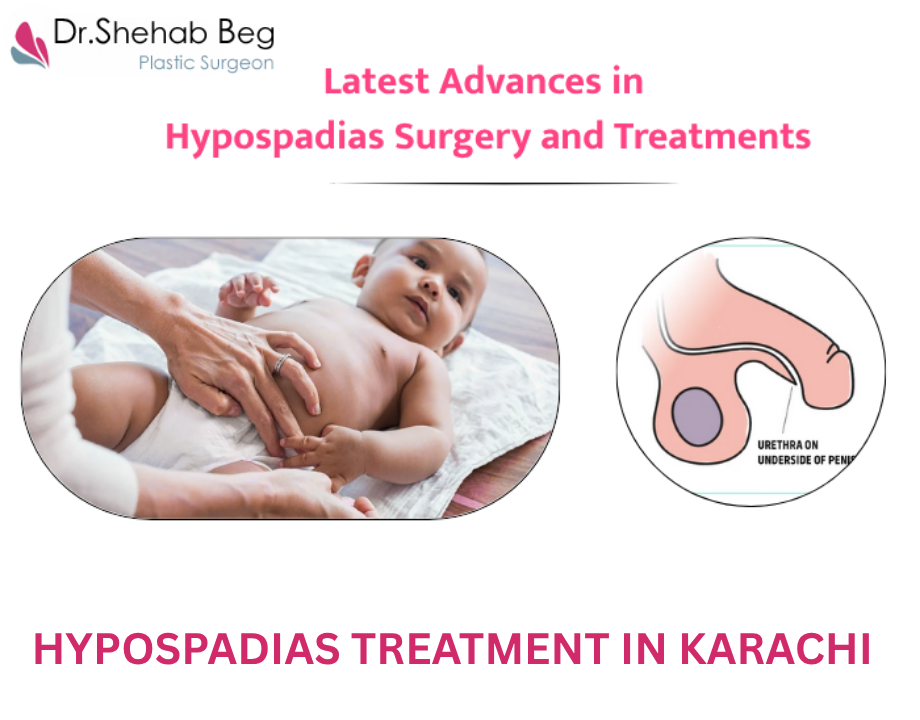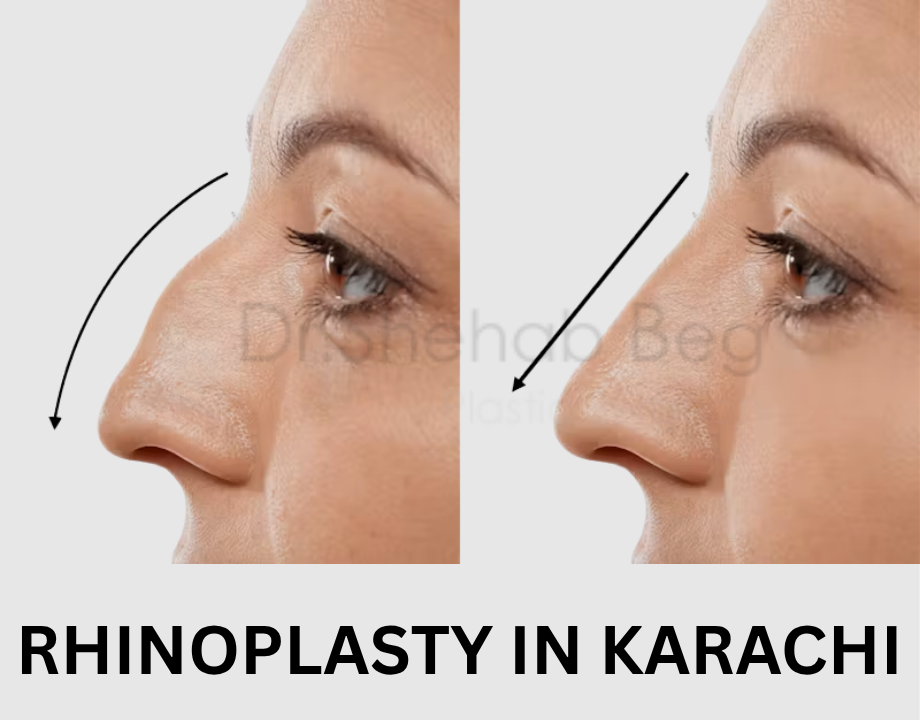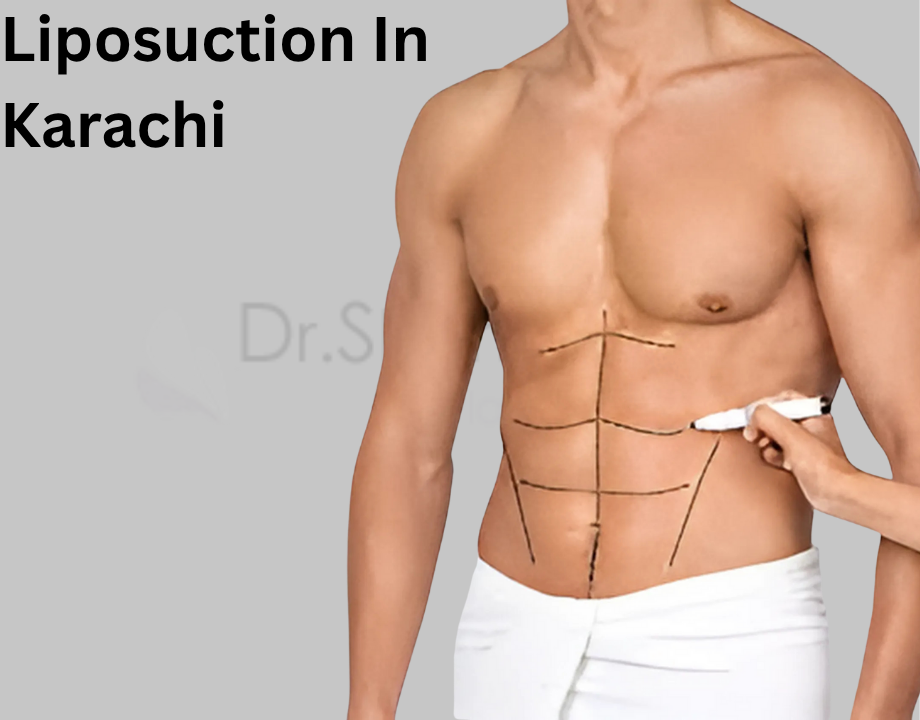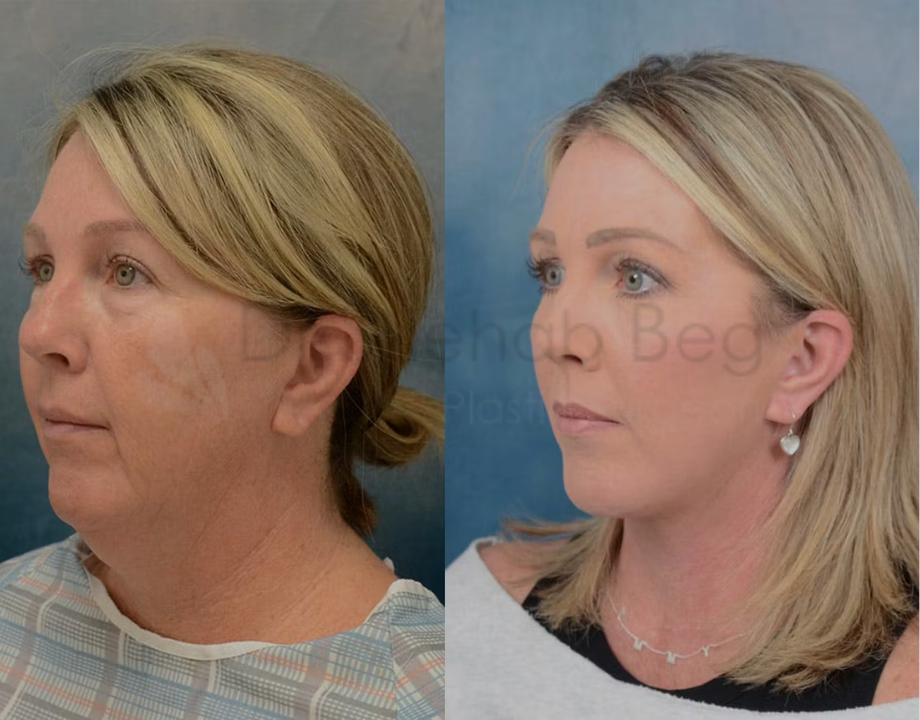Facelift in Karachi | Facelift Treatment in Karachi | Dr Shehab Beg
A facelift is the most comprehensive approach to treating facial wrinkles and sagging caused by aging. The surgery varies from minimally invasive ‘lunchtime lifts’ to more extensive, sophisticated surgery. A facelift removes excess skin, tightens underlying tissues and muscles, and redrapes facial and neck skin. It can correct midface sagging, marionette lines, jowls, and a double chin.
maintaining its reputation as the ‘gold standard’ for facial rejuvenation. Thousands of people undergo successful facelift surgery every year and are pleased with the results.
WHAT DOES IT TRY TO ACCOMPLISH
It makes the face and neck look younger by removing jowls, wrinkles, and spare skin. It can be combined with Blepharoplasty and lip dermabrasion.
HOW IS IT DONE
The skin of the face and neck is pulled upwards and backward. At the same time, fatty deposits under the chin and along the jaw line can be removed, and the muscles tightened. If indicated, the cheeks can be filled out to give a more round and youthful look.
HOW LONG DOES THE OPERATION TAKE
Two to three hours.
HOW LONG IS THE STAY IN THE CLINIC
Maximum of three nights
TYPE OF STITCHES
Thin plastic stitches in front of the ears and silk stitches in the scalp
HOW LONG ARE THEY LEFT IN
The ones in the front of the ears come out in three days, and the others are removed in two weeks, usually at your post-op appointment.
TYPE OF DRESSING
Bulky padded bandages
HOW LONG IS IT LEFT ON
Two days
BRUISING
It can be very severe but usually is not
SWELLING
It is very variable, but there is nearly always swelling below and in front of the ears.
PAIN
It is not usually painful, but there is a tight feeling at the back of the neck, and neuralgic sensations in the neck are common.
WHERE ARE THE SCARS, AND HOW BAD ARE THEY
It is mainly hidden in the temporal scalp and behind the ear, but there will be a fine line in front of the ears. After the operation, the hairline will be a little further back.
HOW LONG DOES IT TAKE TO RECOVER
Two or three weeks
WHEN IS THE FINAL RESULT
Six weeks
HOW LONG DOES IT LAST
Permanent, but aging continues, the wrinkles will form again with time.
COMMON COMPLICATIONS
If bleeding occurs post-operatively, the bruising and swelling will be much worse than usual. The wound behind the ear can take some time to heal; a problem encountered more often in smokers. The skin in front of the ears will often be numb, lasting for several months.
Your surgeon must be properly qualified to do the operation, and he will advise you on what can and cannot be achieved in your case. Do take that advice. Dr. Mirza Shehab Afzal Beg is a British-trained plastic surgeon with the highest qualification of Plastic surgery in the UK, i.e., FRCS (Plast), which no other surgeon practicing in Pakistan has. He has also worked as a Consultant in Plastic Surgery in the UK. On his return from the UK, he is based at Liaquat National Hospital and is also an honorary consultant at Aga Khan Hospital. He has his cosmetic surgery and hair transplant set up at Clifton, Karachi.
Problems of the aging face (Face Lift)
As part of the aging process, which happens to us all sooner or later, our skin progressively loses its elasticity, and our muscles tend to slacken. The effect of this process on the face is to cause the folds in the smile lines to deepen, the corners of the mouth to droop, the jaw-line to sag, and the skin of the neck to fall into loose folds. Around the eyes, the eyebrows droop, and skin in the eyelids gathers in loose folds. Fine wrinkles develop in the skin, especially on the lips and lines of expression such as frown lines and forehead creases deepen. The rate at which this happens varies from one person to another and is probably determined by our genes. Whilst most people accept these changes in appearance, some people, for various reasons, become self-conscious of them and, as a result, begin to lose self-confidence.
Substantial weight loss in people who are excessively overweight can produce similar changes in facial appearance to those of the aging process.
What can be done?
Several operations can be done to rejuvenate the aging face.This fact sheet talks about the operation called Facelift (or Rhytidectomy).
It is designed to fix loose skin on the neck, sagging jawlines, drooping mouth corners, and deep smile lines.
If you want information about other operations, you should check the other fact sheets.
For example, “The Wrinkles on My Face and Lips” talks about chemical peeling, dermabrasion, and filler injections.
“MY FROWN LINES AND FOREHEAD CREASES”
The topic “My Eyelids Look Baggy” talks about the surgery called Blepharoplasty, brow lift, and Botox injections.
This surgery can be combined with a facelift.
Dr. Shehab Beg will guide you on which combination is best for you.
In a Facelift operation, cuts are made on each side of the head.
It starts above the ear, runs behind the hairline, comes down to the top of the ear, and moves in front where the ear meets the cheek.
Then, it curves around the earlobe and goes up behind the ear into the scalp.
Dr. Shehab Beg can explain and show you the exact path of the cut.
During surgery, the skin of the temples, cheeks, and neck is loosened from the muscle-like layer below.
This lets the surgeon pull the skin upwards and backwards.
Extra skin is trimmed away, and the new tight skin is stitched to the original line.
Sometimes, the underlying muscle layer is also tightened.
This gives better and longer-lasting results.
If there is too much fat under the chin, it can be cut out or sucked out during the facelift.
What are the consequences?
This is a good operation to eliminate the aging features caused by loose and inelastic skin. It lasts well, in contrast to the so-called “mini-lift,” in which a pleat of skin is only removed, with the result that the sag usually returns within months. After the facelift procedure, one is left with scars, which are mostly hidden within the hairline above and behind the ears.
Where the scar lies in front of your ears, it is fine, and once it has lost its initial pinkness, it is usually hardly visible. Because hairless skin of the face and neck moves upwards, you will find that your hairline starts higher up after the operation, both in front of your ear and behind your ear. If you are a man, your bearded skin will lie closer to your ear and extend backward below your earlobes. You will have temporary bruising, which should fade completely within 2-3 weeks. You will also find your cheeks and neck numb and stiff for several weeks.
What are the limitations?
A face lift has no effect on fine creasing of the lips, which, if a problem, would need treatment by chemical peeling, dermabrasion, or filler injections (see above).
The rejuvenating effects of a facelift will not last forever. The ageing process will continue after the operation and your skin will lose its elasticity. The operation will not worsen this process; you will always look younger than your age. However, if your ageing features return sooner rather than later, such as putting on a lot of weight and then losing it, the facelift operation can usually be repeated.
What are the risks?
Generally speaking, this is a safe operation, and the risk of complications is low. But you should.
take notes of the following:
BLEEDING from a broken blood vessel is rare and may require you to go back to theatre to block the. Small blood leakages occur more frequently and show up as slight THICKENING under the skin.
They usually absorb naturally but occasionally need to be drained.
INFECTION is extremely rare and is treatable with antibiotics.
Very rarely, a nerve responsible for moving part of the face can be damaged, causing paralysis of the affected muscle.
When this happens, the nerve usually recovers over months
Some of the skin can die off if the tension of the lift impairs its CIRCULATION. It usually heals but leaves a wider scar and possible a bald patch if the hairy skin of the temple is affected. This can however be corrected very easily.
PATIENTS WHO SMOKE CIGARETTES ARE PARTICULARLY AT RISK FROM THIS COMPLICATION
Some patients have an inborn tendency for scars to stretch, and some form scars that stay thick, red, and irritable for a long time. The risk of poor scarring on the face is small. There may be a narrow strip of hair loss along the line of the scars in the scalp.
What you should do before your operation?
If you are overweight and you intend to lose it, you should do so before your operation. Preferably, patients should be some 4lbs below their normal weight at the time of surgery since this allows the surgeon to remove more skin and achieve a more pleasing result. It is wise to stop taking the contraceptive pill six weeks before and use an alternative method to reduce the risk of thrombosis in your leg veins. The same applies to Aspirin and Asprin-containing tablets, which increase the risk of bleeding. If you smoke, you should stop now, and it is wise to cut down on your alcohol consumption.
If you wish, you can have your hair permed and tinted before your operation, as fresh scars are sensitive to these chemicals. You should thoroughly shampoo your hair the night before your operation.
What you should expect at the time of your operation?
You will need to be in the hospital for one or two days. The operation may be done either under general anesthetic or local anesthetic with sedation. It is not a painful operation; it is more uncomfortable due to the tightness of the dressings and the effects of the operation. The dressings are usually removed after 2-3 days.
What you should do after your operation?
Remember to keep your head upright and sleep propped up in bed for the first few days. You should also try to avoid moving your head too suddenly from side to side so that you do not strain your stitches unnecessarily.
On the third or fourth day after your operation, you can start washing your hair with a mild shampoo and blow-drying it very gently. This will make you feel better and make it easier for you to have your stitches removed between 4 and 10 days after your operation.
When shampooing, avoid hanging your head down. You should be able to visit your hairdresser after three weeks and there is no reason why you should not have your hair tinted at that time provided the scars are completely healed.
After four days, you can wear makeup on your face to hide any discolouration or bruising, but you MUST keep it away from your stitches. It is advisable for you to take two weeks off work. This will also prevent bruising and swelling before you resume your normal lifestyle.
Making up your mind?
There is no “best age” to have a facelift. If you are self-conscious about your face’s sagging appearance or you dislike the untidiness of loose skin in your neck and you are prepared to have an operation, then certainly you should visit and discuss the question further with Dr. Shehab Beg, whatever your age. Do remember, however, that we are talking about an operation that takes 2-3 hours to do.
Contact Us
Email ID: ahtcspk@yahoo.com
Contact no: 0323 2847513
Facebook Pages:
Karachi Plastic Surgery
Dr Shehab Beg Plastic Surgeon
Advanced Hair Transplant & Plastic Surgery
Website:
Dr Shehab Beg
AHTCH
Karachi Plastic surgery
Facelift in Karachi | Facelift Treatment in Karachi | Dr Shehab Beg
A facelift is the most comprehensive approach to treating facial wrinkles and sagging caused by aging. The surgery varies from minimally invasive ‘lunchtime lifts’ to more extensive, sophisticated surgery. A facelift removes excess skin, tightens underlying tissues and muscles, and redrapes facial and neck skin. It can correct midface sagging, marionette lines, jowls, and a double chin.
maintaining its reputation as the ‘gold standard’ for facial rejuvenation. Thousands of people undergo successful facelift surgery every year and are pleased with the results.
WHAT DOES IT TRY TO ACCOMPLISH
It makes the face and neck look younger by removing jowls, wrinkles, and spare skin. It can be combined with Blepharoplasty and lip dermabrasion.
HOW IS IT DONE
The skin of the face and neck is pulled upwards and backward. At the same time, fatty deposits under the chin and along the jaw line can be removed, and the muscles tightened. If indicated, the cheeks can be filled out to give a more round and youthful look.
HOW LONG DOES THE OPERATION TAKE
Two to three hours.
HOW LONG IS THE STAY IN THE CLINIC
Maximum of three nights
TYPE OF STITCHES
Thin plastic stitches in front of the ears and silk stitches in the scalp
HOW LONG ARE THEY LEFT IN
The ones in the front of the ears come out in three days, and the others are removed in two weeks, usually at your post-op appointment.
TYPE OF DRESSING
Bulky padded bandages
HOW LONG IS IT LEFT ON
Two days
BRUISING
It can be very severe but usually is not
SWELLING
It is very variable, but there is nearly always swelling below and in front of the ears.
PAIN
It is not usually painful, but there is a tight feeling at the back of the neck, and neuralgic sensations in the neck are common.
WHERE ARE THE SCARS, AND HOW BAD ARE THEY
It is mainly hidden in the temporal scalp and behind the ear, but there will be a fine line in front of the ears. After the operation, the hairline will be a little further back.
HOW LONG DOES IT TAKE TO RECOVER
Two or three weeks
WHEN IS THE FINAL RESULT
Six weeks
HOW LONG DOES IT LAST
Permanent, but aging continues, the wrinkles will form again with time.
COMMON COMPLICATIONS
If bleeding occurs post-operatively, the bruising and swelling will be much worse than usual. The wound behind the ear can take some time to heal; a problem encountered more often in smokers. The skin in front of the ears will often be numb, lasting for several months.
Your surgeon must be properly qualified to do the operation, and he will advise you on what can and cannot be achieved in your case. Do take that advice. Dr. Mirza Shehab Afzal Beg is a British-trained plastic surgeon with the highest qualification of Plastic surgery in the UK, i.e., FRCS (Plast), which no other surgeon practicing in Pakistan has. He has also worked as a Consultant in Plastic Surgery in the UK. On his return from the UK, he is based at Liaquat National Hospital and is also an honorary consultant at Aga Khan Hospital. He has his cosmetic surgery and hair transplant set up at Clifton, Karachi.
Problems of the aging face (Face Lift)
As part of the aging process, which happens to us all sooner or later, our skin progressively loses its elasticity, and our muscles tend to slacken. The effect of this process on the face is to cause the folds in the smile lines to deepen, the corners of the mouth to droop, the jaw-line to sag, and the skin of the neck to fall into loose folds. Around the eyes, the eyebrows droop, and skin in the eyelids gathers in loose folds. Fine wrinkles develop in the skin, especially on the lips and lines of expression such as frown lines and forehead creases deepen. The rate at which this happens varies from one person to another and is probably determined by our genes. Whilst most people accept these changes in appearance, some people, for various reasons, become self-conscious of them and, as a result, begin to lose self-confidence.
Substantial weight loss in people who are excessively overweight can produce similar changes in facial appearance to those of the aging process.
What can be done?
Several operations can be done to rejuvenate the aging face. This fact sheet deals with the operation called FACELIFT (or RHITIDECTOMY), which is designed to correct the loose skin of the neck, the sagging jaw-line, the drooping corners of the mouth, and the deeper smile lines. For further information on other operations, you should read the other factsheets, e.g., “THE WRINKLES ON MY FACE AND LIPS,” which deals with chemical peeling, dermabrasion, and filler injections.
“MY FROWN LINES AND FOREHEAD CREASES”
“MY EYELIDS LOOK BAGGY” deals with the operation called Blepharoplastybrow lift and Botox injections, and “MY EYELIDS LOOK BAGGY” deals with the operation called .
One or more of these operations can be combined with a facelift, and Dr. Shehab Beg will be able to discuss with you which combination of operations is best for your problem.
In the FACELIFT operation, the skin is cut on each side of the head, starting above the ears well behind the hairline, running down to the top of the ear, then in front of the ear where it joins the cheek, then round its lobe and up in the groove behind the ear and then backward into the hairy scalp. The approximate course of this incision is illustrated and can be described to you by Dr. Shehab Beg. -The skin of the temples, cheeks, and neck is freed like a sheet from the muscle-like tissue which lies underneath so that it can be tightened upwards and backward.
Surplus skin is cut away so that the tightened skin fits precisely the shape of the original incision to which it is stitched. Quite often, the layer of muscle-like tissue which lies underneath the skin is also treated in a similar way to give a more lasting result. If there is a problem of excess fat underneath the chin, it can usually be cut away or sucked out during the operation.
What are the consequences?
This is a good operation to eliminate the aging features caused by loose and inelastic skin. It lasts well, in contrast to the so-called “mini-lift,” in which a pleat of skin is only removed, with the result that the sag usually returns within months. After the facelift procedure, one is left with scars, which are mostly hidden within the hairline above and behind the ears.
Where the scar lies in front of your ears, it is fine, and once it has lost its initial pinkness, it is usually hardly visible. Because hairless skin of the face and neck moves upwards, you will find that your hairline starts higher up after the operation, both in front of your ear and behind your ear. If you are a man, your bearded skin will lie closer to your ear and extend backward below your earlobes. You will have temporary bruising, which should fade completely within 2-3 weeks. You will also find your cheeks and neck numb and stiff for several weeks.
What are the limitations?
A face lift has no effect on fine creasing of the lips, which, if a problem, would need treatment by chemical peeling, dermabrasion, or filler injections (see above).
The rejuvenating effects of a facelift will not last forever. The ageing process will continue after the operation and your skin will lose its elasticity. The operation will not worsen this process; you will always look younger than your age. However, if your ageing features return sooner rather than later, such as putting on a lot of weight and then losing it, the facelift operation can usually be repeated.
What are the risks?
Generally speaking, this is a safe operation, and the risk of complications is low. But you should.
take notes of the following:
BLEEDING from a broken blood vessel is rare and may require you to go back to theatre to block the. Small blood leakages occur more frequently and show up as slight THICKENING under the skin.
They usually absorb naturally but occasionally need to be drained.
INFECTION is extremely rare and is treatable with antibiotics.
Very rarely, a nerve responsible for moving part of the face can be damaged, causing paralysis of the affected muscle.
When this happens, the nerve usually recovers over months
Some of the skin can die off if the tension of the lift impairs its CIRCULATION. It usually heals but leaves a wider scar and possible a bald patch if the hairy skin of the temple is affected. This can however be corrected very easily.
PATIENTS WHO SMOKE CIGARETTES ARE PARTICULARLY AT RISK FROM THIS COMPLICATION
Some patients have an inborn tendency for scars to stretch, and some form scars that stay thick, red, and irritable for a long time. The risk of poor scarring on the face is small. There may be a narrow strip of hair loss along the line of the scars in the scalp.
What you should do before your operation?
If you are overweight and you intend to lose it, you should do so before your operation. Preferably, patients should be some 4lbs below their normal weight at the time of surgery since this allows the surgeon to remove more skin and achieve a more pleasing result. It is wise to stop taking the contraceptive pill six weeks before and use an alternative method to reduce the risk of thrombosis in your leg veins. The same applies to Aspirin and Asprin-containing tablets, which increase the risk of bleeding. If you smoke, you should stop now, and it is wise to cut down on your alcohol consumption.
If you wish, you can have your hair permed and tinted before your operation, as fresh scars are sensitive to these chemicals. You should thoroughly shampoo your hair the night before your operation.
What you should expect at the time of your operation?
You will need to be in the hospital for one or two days. The operation may be done either under general anesthetic or local anesthetic with sedation. It is not a painful operation; it is more uncomfortable due to the tightness of the dressings and the effects of the operation. The dressings are usually removed after 2-3 days.
What you should do after your operation?
Remember to keep your head upright and sleep propped up in bed for the first few days. You should also try to avoid moving your head too suddenly from side to side so that you do not strain your stitches unnecessarily.
On the third or fourth day after your operation, you can start washing your hair with a mild shampoo and blow-drying it very gently. This will make you feel better and make it easier for you to have your stitches removed between 4 and 10 days after your operation.
When shampooing, avoid hanging your head down. You should be able to visit your hairdresser after three weeks and there is no reason why you should not have your hair tinted at that time provided the scars are completely healed.
After four days, you can wear makeup on your face to hide any discolouration or bruising, but you MUST keep it away from your stitches. It is advisable for you to take two weeks off work. This will also prevent bruising and swelling before you resume your normal lifestyle.
Making up your mind?
There is no “best age” to have a facelift. If you are self-conscious about your face’s sagging appearance or you dislike the untidiness of loose skin in your neck and you are prepared to have an operation, then certainly you should visit and discuss the question further with Dr. Shehab Beg, whatever your age. Do remember, however, that we are talking about an operation that takes 2-3 hours to do.
Contact Us
Email ID: ahtcspk@yahoo.com
Contact no: 0323 2847513
Facebook Pages:
Karachi Plastic Surgery
Dr Shehab Beg Plastic Surgeon
Advanced Hair Transplant & Plastic Surgery
Website:






